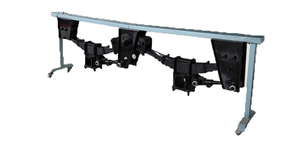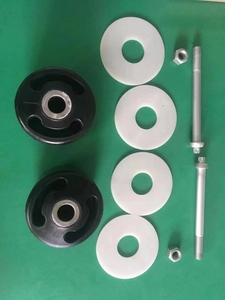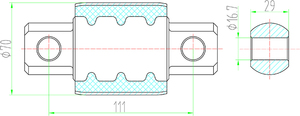Types of Hendrickson Suspension Systems
Hendrickson offers a diverse range of suspension systems engineered for specific applications in the commercial transportation industry. Each type is designed with unique features to optimize performance for different vehicle types and operating conditions.
Specialized systems designed for trailer applications that provide:
- Optimal weight distribution across trailer axles
- Enhanced stability at highway speeds
- Improved shock absorption for cargo protection
- Superior towing control and maneuverability
- Simplified maintenance with fewer moving parts
- Increased ground clearance for off-road capability
Best for: Freight haulers, flatbeds, tankers, and specialty trailers
Robust systems engineered for maximum durability in demanding conditions:
- Superior durability on rough terrain
- High load capacity for heavy freight
- Versatile applications (logging, construction, mining)
- Enhanced driver comfort for long hauls
- Reduced maintenance requirements
- Extended service life in severe conditions
Best for: Class 8 trucks, dump trucks, cement mixers, logging vehicles
Specialized systems focused on passenger comfort and urban maneuverability:
- Optimized ride quality for passenger comfort
- Designed for frequent stop-and-go operations
- Enhanced stability for larger transit vehicles
- Ideal for both city and intercity applications
- Reduced road vibration transmission
- Kneeling capability for accessibility
Best for: Transit buses, coach buses, school buses, shuttle services
Balanced systems for medium-duty applications:
- Improved handling characteristics under load
- Increased cargo capacity ratings
- Lower maintenance requirements
- Better weight distribution
- Enhanced stability during cornering
- Adaptable to various body configurations
Best for: Delivery trucks, utility vehicles, box trucks, service vehicles
Industry Insight: Hendrickson's air suspension systems are increasingly becoming the standard for premium ride quality in the commercial transportation sector, particularly for vehicles that travel long distances or carry sensitive cargo requiring minimal vibration.
Specifications and Maintenance of Hendrickson Suspension
Understanding the technical specifications of Hendrickson suspension systems is crucial for proper selection, installation, and maintenance. These specifications determine compatibility with specific vehicles and applications.
8,000 lbs to 52,000 lbs depending on model
Single, tandem, tridem, and multi-axle options
3" to 8" vertical travel range
Adjustable from 6.5" to 19" in most models
Key Technical Specifications
Load Capacity
Every Hendrickson suspension has a specific maximum weight rating. Selecting a system with appropriate capacity ensures:
- Safe operation without compromising structural integrity
- Optimal performance throughout the suspension's service life
- Compliance with regulatory weight requirements
- Prevention of premature component failure
Axle Placement
Hendrickson systems offer various axle configurations that affect:
- Weight distribution across the chassis
- Vehicle stability during operation
- Turning radius and maneuverability
- Compliance with bridge laws and road regulations
Suspension Travel
The vertical movement range of the suspension system impacts:
- Ride quality and comfort for drivers/passengers
- Vehicle handling characteristics under load
- Off-road capability and obstacle clearance
- Protection of cargo from road impact
Spring Rating
Hendrickson leaf spring designs provide:
- Primary load support for the suspension system
- Shock absorption for road irregularities
- Varying levels of stiffness for different applications
- Predictable ride characteristics under varying loads
Shock Absorber
Integrated shock absorbers are critical for:
- Controlling suspension oscillation and rebound
- Minimizing impact from road hazards
- Maintaining tire contact with the road surface
- Protecting vehicle components from excessive movement
Essential Maintenance Practices
Proper maintenance of Hendrickson suspension systems extends service life, ensures safety, and optimizes performance. Follow these maintenance guidelines:
| Maintenance Task | Frequency | Importance | Special Notes |
|---|---|---|---|
| Air Pressure Check | Weekly | Critical | Maintain manufacturer's recommended pressure levels to prevent system damage |
| Shock Absorber Inspection | Monthly | High | Check for leaks, damage, and proper mounting; replace in pairs when needed |
| Bushing Inspection | Quarterly | Medium | Look for cracks, tears, or excessive wear that could affect handling |
| Lubrication | Per schedule | High | Use manufacturer-approved lubricants on pivot points and wear surfaces |
| Comprehensive Inspection | Semi-annually | Critical | Thorough evaluation of all suspension components for wear and damage |
Safety Warning: Never work under a vehicle supported only by jacks. Always use proper safety stands and follow recommended safety procedures when inspecting or servicing suspension components.
How to Choose the Right Hendrickson Suspension
Selecting the appropriate Hendrickson suspension system requires careful analysis of your specific application needs, operating conditions, and vehicle specifications. The right choice will optimize performance, safety, and long-term value.
Load Capacity Requirements
Accurately assess your vehicle's:
- Empty vehicle weight (chassis and body)
- Maximum payload weight anticipated
- Weight distribution patterns
- Safety margin requirements (typically 15-20% above maximum load)
Ride Height Considerations
Evaluate the optimal ride height based on:
- Loading dock compatibility requirements
- Ground clearance needs for your operating terrain
- Body installation specifications
- Adjustability requirements for multiple applications
Durability Requirements
Consider your operating environment:
- Road surface conditions (highway vs. off-road)
- Climate factors (temperature, humidity, salt exposure)
- Service intensity (daily hours of operation)
- Expected service life of the vehicle
Installation & Maintenance
Evaluate practical considerations:
- Ease of installation for your equipment/facilities
- Availability of qualified service providers
- Accessibility of maintenance points
- Parts availability in your region
Cost Analysis
Conduct a thorough cost evaluation:
- Initial acquisition cost vs. competitors
- Projected maintenance expenses over service life
- Weight savings impact on fuel economy/payload capacity
- Resale/trade-in value impact
- Warranty coverage and terms
Expert Recommendation: When possible, consult with both Hendrickson representatives and operators using similar suspension systems in comparable applications. Real-world performance feedback can provide invaluable insights beyond specification sheets.
DIY Installation and Replacement Guide
While Hendrickson suspension replacement can be complex, experienced mechanics with proper tools and knowledge can successfully complete this task. Follow this step-by-step process for safe and effective installation:
- Gather necessary tools and equipment - You'll need socket sets, wrenches, torque wrenches, jacks, safety stands, and specialty tools specified in the service manual.
- Obtain correct replacement components - Verify compatibility with your vehicle model and application by consulting the manufacturer's documentation or authorized dealers.
- Prepare the vehicle - Position on a flat, level surface, engage parking brakes, and place wheel chocks on wheels opposite to the working area to prevent movement.
- Secure the vehicle properly - Raise the vehicle using appropriate jacks, then install safety stands to support the frame. Never rely solely on hydraulic jacks during maintenance.
- Drain hydraulic systems - If applicable, properly drain and contain all hydraulic fluids before disassembly to prevent spillage and environmental contamination.
- Document and remove old components - Take photos or notes of the original installation, then systematically remove fasteners and worn components, keeping track of all hardware.
- Clean mounting surfaces - Thoroughly clean all contact surfaces and inspect the frame for cracks or damage before installing new components.
- Install new suspension components - Follow the manufacturer's specific installation sequence, using new hardware where recommended and applying proper torque to all fasteners.
- Reconnect and refill systems - Reattach all disconnected components, refill fluids to recommended levels, and perform system bleeding procedures if required.
- Perform final inspection and testing - Lower the vehicle carefully, remove jacks, and verify all components are correctly installed before conducting a low-speed test drive to check for proper operation.
Important Safety Notice: Suspension replacement affects vehicle safety, stability, and handling characteristics. If you lack experience or proper equipment, professional installation is strongly recommended. Always follow manufacturer torque specifications and installation procedures.
Frequently Asked Questions
The Hendrickson suspension system encompasses a comprehensive range of truck, trailer, and bus suspensions engineered for diverse commercial vehicle applications. These systems integrate advanced design elements to provide optimal control, comfort, and durability. Hendrickson suspensions are specifically created to enhance vehicle performance across various operating environments, including standard highway travel, vocational use, and severe service applications.
These systems are distinguished by their ability to balance ride quality with load-handling capabilities, resulting in extended vehicle life and reduced operational costs. The Hendrickson portfolio includes air-ride, mechanical, rubber, and composite spring suspensions tailored to specific industry needs.
Hendrickson suspensions deliver numerous benefits that have established them as industry leaders:
- Superior Ride Quality: Advanced damping technologies and material science create exceptional driver comfort, reducing fatigue during long hauls.
- Enhanced Vehicle Control: Precision-engineered systems improve handling characteristics, particularly for trailer applications, resulting in better overall driving performance.
- Improved Safety: Better vehicle control reduces accident risk, especially in challenging road conditions or emergency maneuvers.
- Extended Component Life: By managing road forces more effectively, Hendrickson suspensions reduce stress on vehicle frames, axles, and other critical components.
- Operational Cost Reduction: Lower maintenance requirements, improved fuel efficiency through weight savings, and extended tire life contribute to significant cost benefits over the vehicle's service life.
- Application-Specific Design: Specialized systems for different industries ensure optimal performance in specific working conditions.
Hendrickson suspension systems are utilized across a broad spectrum of commercial transportation sectors:
- Long-haul Freight Carriers: Fleet operators rely on Hendrickson air suspensions for superior driver comfort, cargo protection, and reduced maintenance during cross-country operations.
- Vocational Vehicle Operators: Construction, mining, logging, and refuse companies choose Hendrickson heavy-duty suspensions for durability in demanding environments.
- Bus and Transit Agencies: Public transportation providers select Hendrickson bus suspensions for passenger comfort, reliability, and lower operating costs.
- Specialty Transport Companies: Businesses transporting sensitive equipment, hazardous materials, or oversized loads benefit from Hendrickson's precise handling characteristics.
- Fleet Managers: Decision-makers responsible for vehicle acquisition and maintenance choose Hendrickson systems to optimize total cost of ownership.
- Custom Truck Builders: Specialty vehicle manufacturers integrate Hendrickson suspensions to enhance performance characteristics of purpose-built vehicles.
Proper maintenance is essential for maximizing the performance and service life of Hendrickson suspension systems:
- Regular Component Inspection: Perform visual checks of springs, dampers, air bags, bushings, and mounting hardware for signs of wear, damage, or loosening.
- Environmental Cleaning: Keep suspension components free from build-up of mud, road salt, and debris, especially after operating in harsh conditions.
- Follow Maintenance Schedules: Adhere to manufacturer-recommended inspection intervals and service procedures specific to your suspension model.
- Use Quality Replacement Parts: When repairs are necessary, install genuine Hendrickson components or approved equivalents to maintain performance integrity.
- Proper Lubrication: Apply specified lubricants to pivot points, bushings, and other wear surfaces according to maintenance schedules.
- Monitor Air Systems: For air suspensions, regularly inspect air lines, fittings, and height control valves for proper operation and leaks.
- Address Issues Promptly: Don't delay repairs when problems are identified; minor issues can quickly develop into major failures that compromise safety and increase repair costs.

















































































































































































































































 浙公网安备 33010002000092号
浙公网安备 33010002000092号 浙B2-20120091-4
浙B2-20120091-4